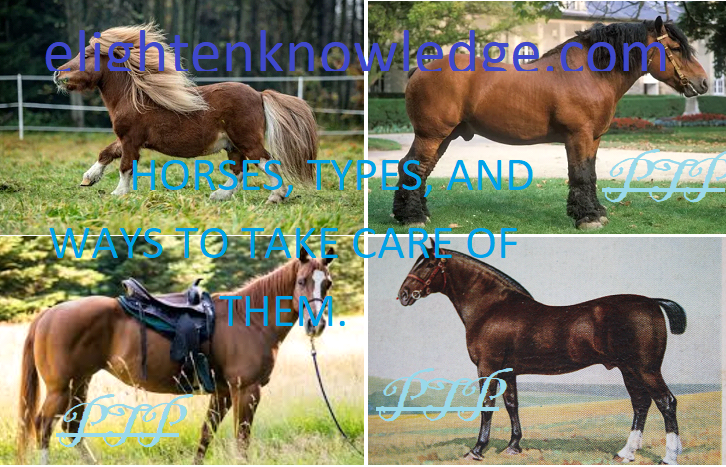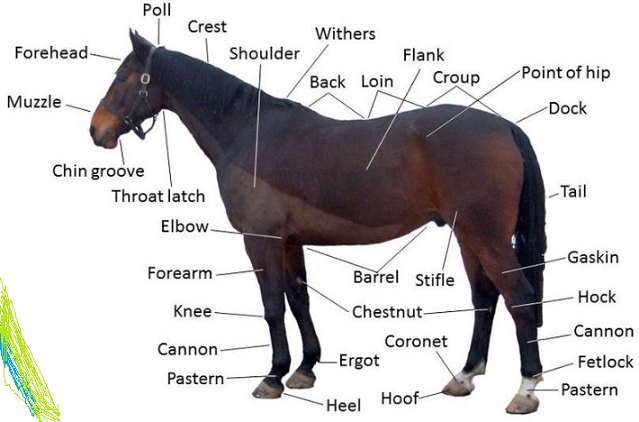Horses, types, and ways to take care of horses

Horses, types, and ways to take care of horses
General Overview Horses
- For hundreds of years, the horse has been the faithful servant and friend of man. Heavy horses carried armor-clad knights into battle.
- They pulled the farmers’ plows and drew the wagons and coaches that were once the only means of land transportation.
- Horses carried man into the hunting field, where he killed animals for food or sport.
- They pulled the stagecoaches and covered wagons that carried pioneers across the plains to settle the West.
- Some horses are big and strong enough to pull heavy wagons and farm machinery.
- Others are lightweight and are fast enough to run in races.
- Still others, like ponies, are very small and make good companions for children.
- The horse has always been able to fit itself to the place where it lives.
- It can speed over the burning sands of the desert, or pull sleighs in lands of snow and ice.
- lt can cut a great many different kinds of plants.
- The horse is among the most intelligent of animals.
- It responds readily to kindness.
- It can remember an injury fora long time.
- Well-trained horses can carry riders safely through the darkest night if they are given free rein.
- They can also find their way back to their stables by themselves.
- Once a milkman’s horse has made a few trips along the route, it will stop before the houses of customers by itself.

Types and Breeds of Horses
There are five main types of modern horses. They are;
- The draft horse,
- Saddle horse,
- Coach or heavy harness horse,
- Roadster or light harness horse
- Pony.
Each type contains various breeds which have been developed to serve some definite purpose.
Production of lettuce (Lactuca sativa) in Ghana.
How to store maize grain at home without the use of chemicals.
Care of Horses
Horses respond readily to careful, intelligent care and feeding.
Feeding Horses.
- Horses should not be fed so much food that they become too fat.
- They do well on feeds that grow in almost any locality, provided they are fed correct amounts.
- They should be fed only hay and grain which is clean and bright looking.
- They should be given a variety of feeds that will supply the right amount of proteins, carbohydrates, fats, minerals, and vitamins.
- The horse should be fed regularly to establish good habits. In changing the kind of feed given to a horse, the change should be made very gradually.
The standard grain for horses is oats.
- The horse likes the taste of oats.
- Oats are easily digested, they contain valuable food elements, and they can be fed safely to horses of all ages and types.
- Oats can be fed whole, rolled, or ground.
- Corn provides the horse with much energy and is better suited to hard-working draft horses than to lighter breeds.
- Young colts should not be fed too much corn because it does not contain the proteins and calcium that are needed to build muscle and bone.
Wheat is also can be used to feed a horse.
- Wheat can be fed to horses, but it should never make above 15% of all the grains given to them.
- Wheat is rich and difficult for a horse to digest.
- It should always be mixed with other feeds.
Bran, linseed meal, cottonseed meal, and soybean oil meal are useful feeds which are rich in proteins.
- They should be fed to horses only in small amounts, not over one to two pounds per day.
- Such feeds are helpful when used together with feeds that contain little protein, such as corn or timothy.
- Timothy is the most widely used hay in feeding horses but is not the most nourishing.
- It is used because it is safe to feed to horses and because it is cleaner than most other hays.
- Timothy is fed more often to light saddle horses than to farm workhorses.
- Alfalfa is probably the kind of roughage that horses like the best.
- It contains much protein, however, and horses should not be fed too much of it.
- Clover is similar to alfalfa, and horses relish it.
- Many horsemen feed a combination of timothy and clover, or timothy and alfalfa, rather than a single kind of hay.
The general rule in feeding horses is this:
- One and one-quarter pounds of hay and one-half to three-quarters of a pound of grain should be given to a horse for every hundred pounds of his weight.
- Thus, a I,200-pound horse would be fed fifteen pounds of hay and nine pounds of grain every day.
- If the horse is not being worked very hard, it can be fed more hay and less grain.
- If the work is heavy, the grain should be increased and the hay decreased.
Horses also need salt.
- Sometimes a salt box is put in a manger so the horse can eat as much salt as it pleases.
- An average horse will eat one or two ounces of salt a day.
Watering horses
- It makes little difference whether a horse is watered before or after it eats.
- It is important, however, to make a definite plan for watering the horse, and to follow the plan every day.
- Care should be taken in watering a horse that has been working hard and is hot.
- The best way to water a warm horse is to let him have a swallow of water, and then pull his head out of the trough.
- This should be repeated until the horse has cooled off and is no longer thirsty.
- If a hot horse is given too much cold water, he is likely to contract an ailment called founder.
- In hot weather, however, horses should be watered in mid-morning and mid-afternoon, as well as at feeding time.
- Like man in hot weather, horses lose water from their bodies by perspiring.
Horse pasture.
- It is important that a horse should have a good pasture where he can eat grass.
- Grass is a natural feed for horses and they thrive on it.
- If horses are not being worked, grass alone will provide them with enough food.
- A workhorse should have grain and dried hay added to its food, but in smaller amounts.
- A horse can feed on grasses that are covered with snow because it can uncover the grass by pawing the snow away with its front feet.
Grooming horses
- A horse that is kept in a stable should be groomed daily with a body brush and a currycomb.
- Grooming removes dirt from the hair and skin, polishes the hair, and gives the horse a sleek, smooth appearance.
- A well-groomed horse is more contented and rests and looks better.
- A horse that is kept in a pasture does not need to be groomed daily unless it is being worked or ridden.
Stabling.
- In the colder parts of the world, it is necessary to stable working horses during the winter.
- Barns do not have to be kept warm, but the horse should not be kept in a drafty stable.
- Most saddle horses and race horses are kept in box stalls which are 12 by 12 feet square, or even larger.
- The working horse is usually tied in a single stall which is five or six feet wide.
- The horse’s stall should be kept clean.
- A clean bed should be provided of straw or wood shavings, or a combination of both.
Join Enlighten Knowledge WhatsApp Channel.
Join Enlighten Knowledge Telegram platform.







